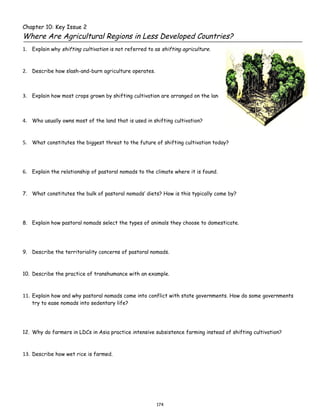
Chapter 10 key isssue 2
- 1. Chapter 10: Key Issue 2 Where Are Agricultural Regions in Less Developed Countries? 1. Explain why shifting cultivation is not referred to as shifting agriculture. 2. Describe how slash-and-burn agriculture operates. 3. Explain how most crops grown by shifting cultivation are arranged on the land. 4. Who usually owns most of the land that is used in shifting cultivation? 5. What constitutes the biggest threat to the future of shifting cultivation today? 6. Explain the relationship of pastoral nomads to the climate where it is found. 7. What constitutes the bulk of pastoral nomads’ diets? How is this typically come by? 8. Explain how pastoral nomads select the types of animals they choose to domesticate. 9. Describe the territoriality concerns of pastoral nomads. 10. Describe the practice of transhumance with an example. 11. Explain how and why pastoral nomads come into conflict with state governments. How do some governments try to ease nomads into sedentary life? 12. Why do farmers in LDCs in Asia practice intensive subsistence farming instead of shifting cultivation? 13. Describe how wet rice is farmed. 174
- 2. 14. Explain why the transition from community owned communes to privately owned farms has been so difficult in China since the Communist government has dismantled the agricultural communes. 15. Identify the types of crops grown on plantations. 16. Explain how the plantation system effected the demographic composition of the United States. Fold the page at the dotted line and then glue this part of the page into your notebook.